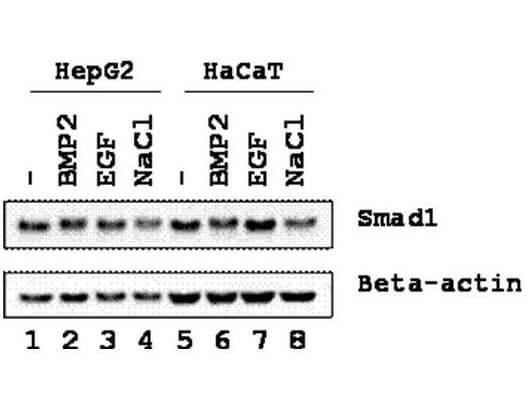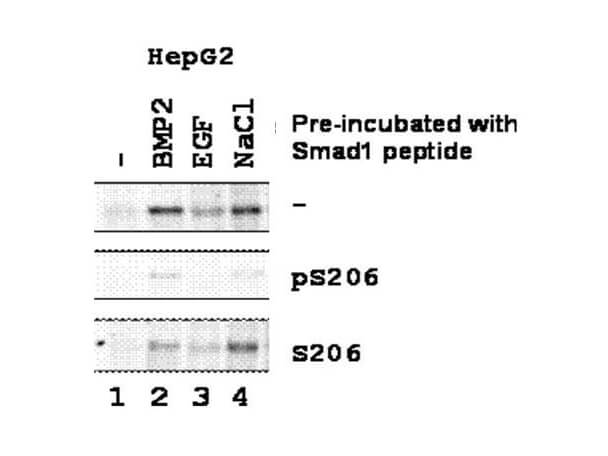Datasheet is currently unavailable. Try again or CONTACT US
SMAD1 Antibody
Rabbit Polyclonal
600-401-B29S
600-401-B29
25 µL
100 µg
Liquid (sterile filtered)
Liquid (sterile filtered)
WB, ELISA
Human
Rabbit
Shipping info:
$50.00 to US & $70.00 to Canada for most products. Final costs are calculated at checkout.
Product Details
Anti-SMAD1 (RABBIT) Antibody - 600-401-B29
rabbit anti-SMAD1 pS206 antibody, SMAD-1, SMAD 1, mothers against decapentaplegic homolog 1 antibody, MAD homolog 1, Mothers against DPP homolog 1, SMAD family member 1, MADH1, MADH 1, Transforming growth factor-beta-signaling protein 1, BSP-1, JV4-1
Rabbit
Polyclonal
IgG
Target Details
SMAD1 - View All SMAD1 Products
Human
Conjugated Peptide
This affinity purified antibody was prepared from whole rabbit serum produced by repeated immunizations with a phosphorylated synthetic peptide corresponding to the region of amino acids containing serine 206 of human SMAD1 protein.
This affinity-purified antibody is directed against the phosphorylated form of human SMAD1 protein at the pS206 residue. The product was affinity purified from monospecific antiserum by immunoaffinity purification. Antiserum was first purified against the phosphorylated form of the immunizing peptide. The resultant affinity purified antibody was then cross adsorbed against the non-phosphorylated form of the immunizing peptide. Reactivity occurs against human SMAD1 pS206 protein and the antibody is specific for the phosphorylated form of the protein. Reactivity with non-phosphorylated human SMAD1 is minimal by ELISA and western blot. A BLAST analysis was used to suggest 100% cross reactivity with SMAD1 from human, Duckbill platypus, Drosophila, mouse, opossum, chimpanzee, bonobo, orangutan, gorilla, macaque, cattle, sheep, pig, rat, horse, salmon, chicken, and dog based on the sequence homology with the immunogen. Reactivity against homologues from other sources is not known.
Application Details
ELISA, WB
This affinity purified antibody has been tested for use in ELISA and by western blot. Specific conditions for reactivity should be optimized by the end user. Expect a band approximately 52 kDa in size corresponding to phosphorylated SMAD1 protein by western blotting in the appropriate stimulated tissue or cell lysate or extract. This antibody is specific for the phosphorylated pS206 of SMAD1. Stimulation of EGF, TGFbeta BMP2, and 0.5M NaCl are recommended for 1 hour. This antibody is useful in ChIP and ChIPSeq.
Formulation
1.31 mg/mL by UV absorbance at 280 nm
0.02 M Potassium Phosphate, 0.15 M Sodium Chloride, pH 7.2
0.01% (w/v) Sodium Azide
None
Shipping & Handling
Dry Ice
Store vial at -20° C prior to opening. Aliquot contents and freeze at -20° C or below for extended storage. Avoid cycles of freezing and thawing. Centrifuge product if not completely clear after standing at room temperature. This product is stable for several weeks at 4° C as an undiluted liquid. Dilute only prior to immediate use.
Expiration date is one (1) year from date of receipt.
SMAD1 is also known Mothers Against Decapentaplegic homolog 1, Mothers against DPP homolog 1, hSMAD-3, JV4-1, Transforming growth factor-Beta-Signaling Protein 1 or BSP1. SMAD proteins are signal transducers and transcriptional modulators that mediate multiple signaling pathways. SMAD1, as a transcriptional modulator, is activated by BMP (Bone Morphogenetic Protein) type 1 receptor kinase (it is a receptor-regulated SMAD or R-SMAD). BMPs are involved in a range of biological activities including cell growth, apoptosis, morphogenesis, development and immune responses. SMAD proteins have been implicated as downstream effectors of TGF beta/BMP signaling. In response to BMP ligands, SMAD1 can be phosphorylated (other sites besides the most prominent of S206, are S187, S195, and S214). S-206 is phosphorylated by ERK in response to mitogenic growth factors, or by recombinant ERK in vitro; this can be tested by treating cells with EGF or in cancer cells where Ras is activated. The phosphorylated form of this protein forms a complex with SMAD4, which is important for its function in the transcription regulation. This protein is also a target for SMAD-specific E3 ubiquitin ligases, such as SMURF1 and SMURF2, and undergoes ubiquitination and proteasome-mediated degradation.
This product is for research use only and is not intended for therapeutic or diagnostic applications. Please contact a technical service representative for more information. All products of animal origin manufactured by Rockland Immunochemicals are derived from starting materials of North American origin. Collection was performed in United States Department of Agriculture (USDA) inspected facilities and all materials have been inspected and certified to be free of disease and suitable for exportation. All properties listed are typical characteristics and are not specifications. All suggestions and data are offered in good faith but without guarantee as conditions and methods of use of our products are beyond our control. All claims must be made within 30 days following the date of delivery. The prospective user must determine the suitability of our materials before adopting them on a commercial scale. Suggested uses of our products are not recommendations to use our products in violation of any patent or as a license under any patent of Rockland Immunochemicals, Inc. If you require a commercial license to use this material and do not have one, then return this material, unopened to: Rockland Inc., P.O. BOX 5199, Limerick, Pennsylvania, USA.


